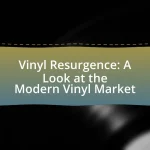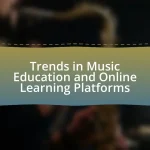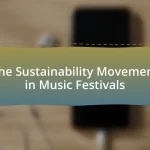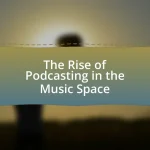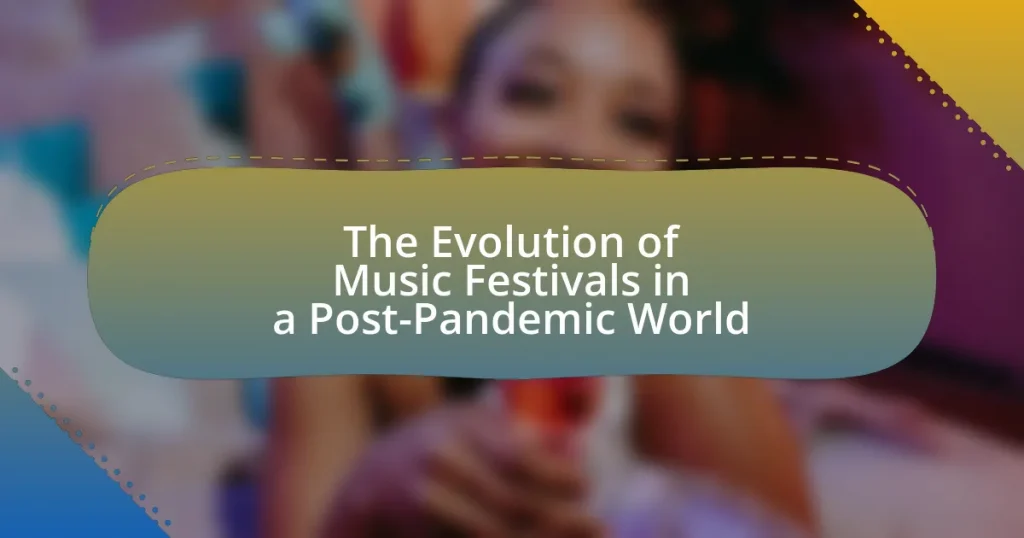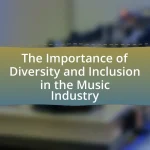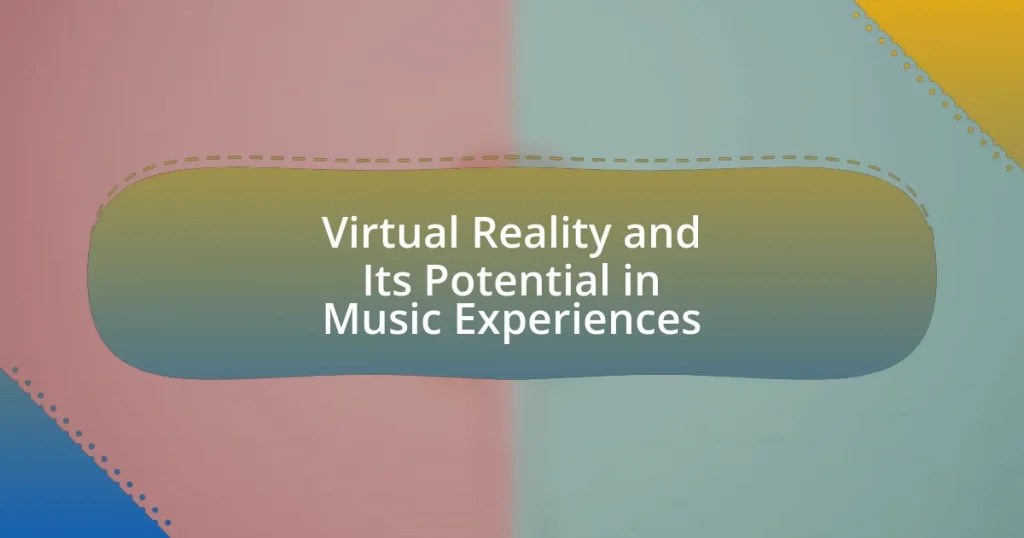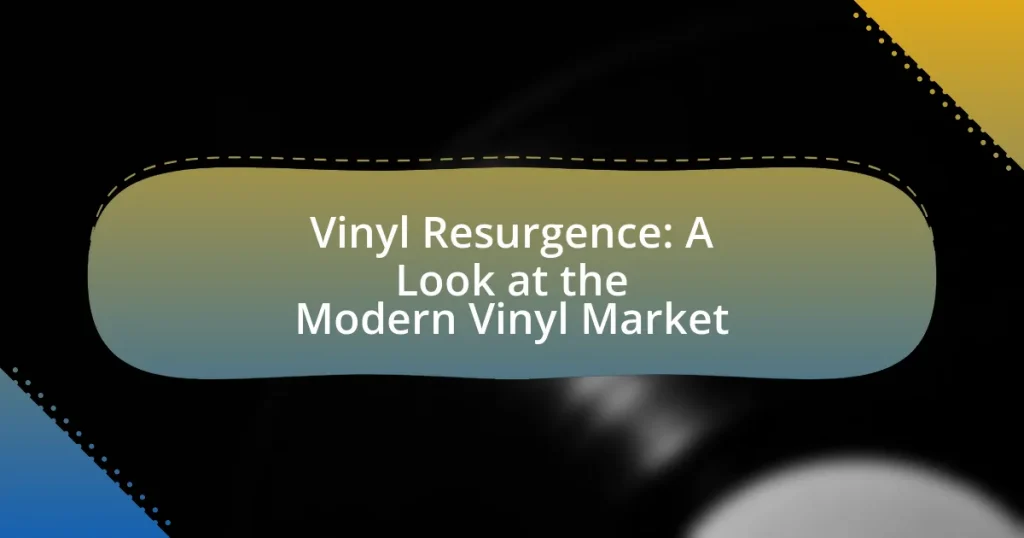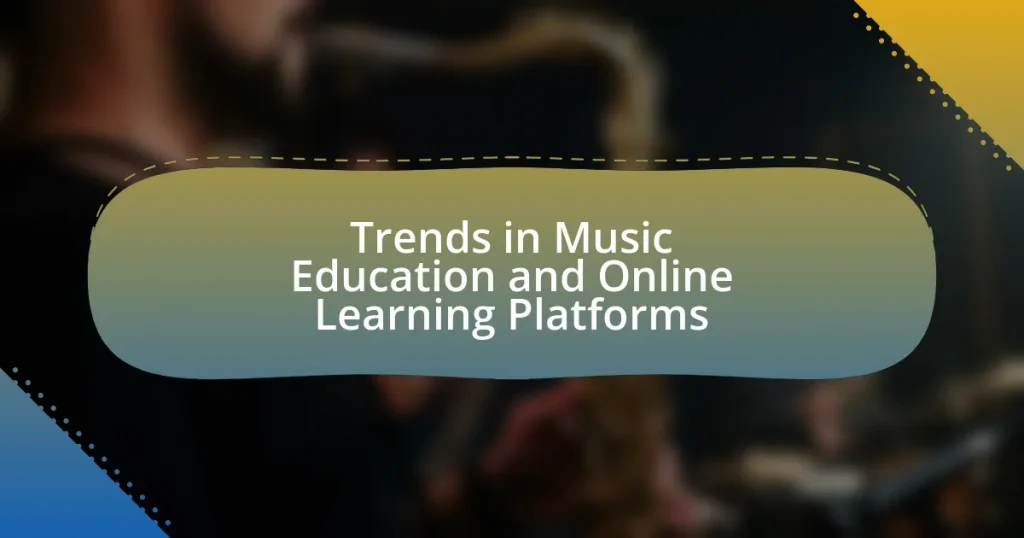The article examines the evolution of music festivals in a post-pandemic world, highlighting key changes such as enhanced health and safety protocols, increased technology integration for virtual experiences, and a shift towards smaller, localized events. It discusses how audience experiences have adapted, emphasizing hybrid models that combine in-person and virtual attendance, as well as the implementation of safety measures like vaccination requirements and contactless entry. Additionally, the article explores emerging trends in sustainability and community engagement, illustrating how festival organizers are responding to changing consumer preferences and the ongoing impact of the pandemic on the music festival landscape.
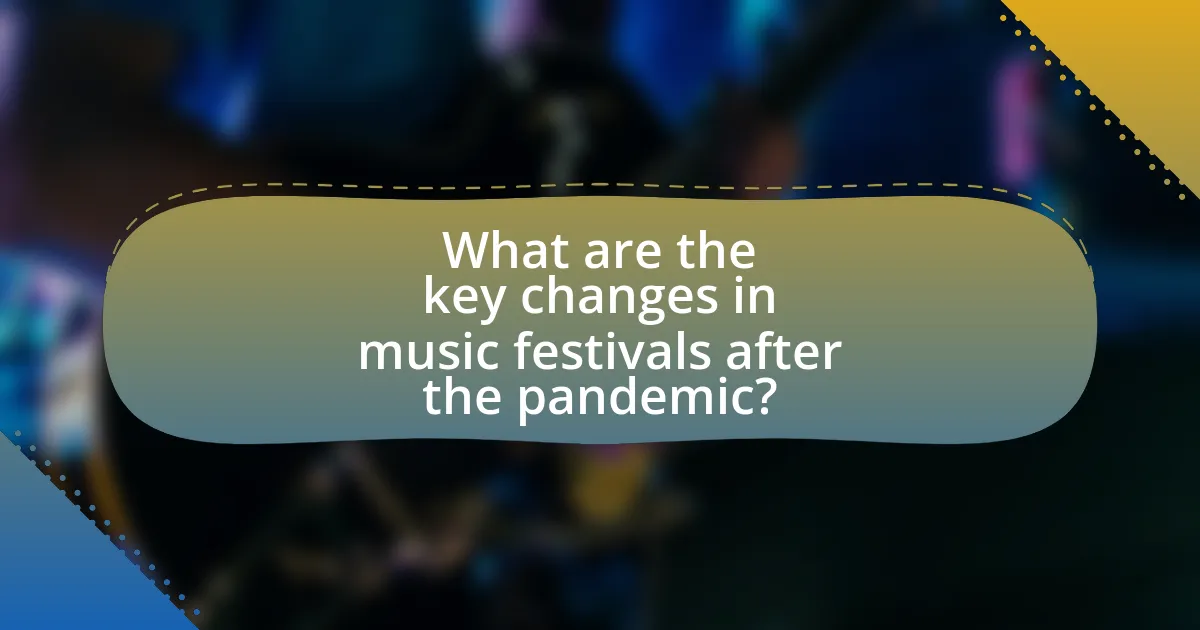
What are the key changes in music festivals after the pandemic?
Key changes in music festivals after the pandemic include enhanced health and safety protocols, increased use of technology for virtual experiences, and a shift towards smaller, more localized events. Health and safety measures, such as vaccination requirements and social distancing, have become standard to ensure attendee safety. Additionally, many festivals have integrated live streaming and virtual attendance options, allowing broader access and participation. The trend towards smaller events is driven by a desire for more intimate experiences and reduced risk, with many organizers focusing on local talent and community engagement. These changes reflect the evolving landscape of music festivals in response to the challenges posed by the pandemic.
How has the audience experience evolved in post-pandemic music festivals?
The audience experience in post-pandemic music festivals has evolved to prioritize health and safety while enhancing engagement through technology. Festivals now implement measures such as contactless entry, increased sanitation, and social distancing protocols to ensure attendee safety. Additionally, many festivals have integrated digital platforms for virtual participation, allowing remote audiences to engage through live streams and interactive features. According to a 2022 survey by Eventbrite, 70% of festival-goers expressed a preference for hybrid experiences that combine in-person and virtual elements, reflecting a significant shift in how audiences interact with live music events.
What safety measures are now implemented at music festivals?
Safety measures now implemented at music festivals include enhanced health screenings, increased sanitation protocols, and crowd management strategies. Health screenings often involve temperature checks and health questionnaires to identify potential COVID-19 symptoms among attendees. Increased sanitation protocols include frequent cleaning of high-touch surfaces and the availability of hand sanitizers throughout the venue. Crowd management strategies involve limiting capacity, implementing social distancing measures, and utilizing contactless ticketing systems to reduce physical interactions. These measures are designed to ensure the safety of attendees and staff, reflecting the ongoing adaptations in response to the pandemic.
How has technology enhanced the festival experience for attendees?
Technology has significantly enhanced the festival experience for attendees by improving accessibility, engagement, and safety. For instance, mobile apps provide real-time updates on schedules, artist lineups, and location maps, allowing attendees to navigate the festival more efficiently. Additionally, cashless payment systems streamline transactions, reducing wait times and enhancing convenience. Virtual reality and augmented reality experiences offer immersive interactions, allowing attendees to engage with performances in innovative ways. Furthermore, advanced health and safety technologies, such as contactless entry and health screening apps, have become essential in ensuring attendee safety in a post-pandemic environment. These technological advancements collectively create a more enjoyable and secure festival experience.
What trends have emerged in the music festival industry post-pandemic?
Post-pandemic, the music festival industry has seen several significant trends emerge, including a focus on health and safety protocols, increased use of technology for virtual experiences, and a shift towards sustainability. Health and safety measures, such as contactless entry and enhanced sanitation, have become standard to reassure attendees. The integration of technology has allowed festivals to offer hybrid models, combining in-person and virtual attendance, which has expanded audience reach. Additionally, there is a growing emphasis on sustainability, with festivals adopting eco-friendly practices, such as waste reduction and carbon offsetting, reflecting a broader societal shift towards environmental responsibility. These trends are supported by industry reports indicating that 70% of festival organizers are prioritizing health measures, and a significant number are investing in sustainable initiatives.
How are music festivals adapting to changing consumer preferences?
Music festivals are adapting to changing consumer preferences by incorporating hybrid models that blend in-person and virtual experiences. This shift responds to the increased demand for accessibility and safety, as evidenced by a 2022 survey indicating that 60% of festival-goers prefer options that allow for both physical attendance and online participation. Additionally, festivals are enhancing their focus on sustainability and wellness, with many implementing eco-friendly practices and offering wellness activities, reflecting a growing consumer interest in health and environmental responsibility.
What role does sustainability play in the evolution of music festivals?
Sustainability plays a crucial role in the evolution of music festivals by driving the adoption of eco-friendly practices and reducing environmental impact. As awareness of climate change and environmental degradation increases, festivals are implementing measures such as waste reduction, renewable energy use, and sustainable sourcing of materials. For instance, events like Glastonbury have committed to becoming carbon neutral by 2025, showcasing a trend where festivals prioritize sustainability to attract environmentally conscious attendees. This shift not only enhances the festival’s reputation but also aligns with broader societal values, making sustainability a key factor in the future development of music festivals.
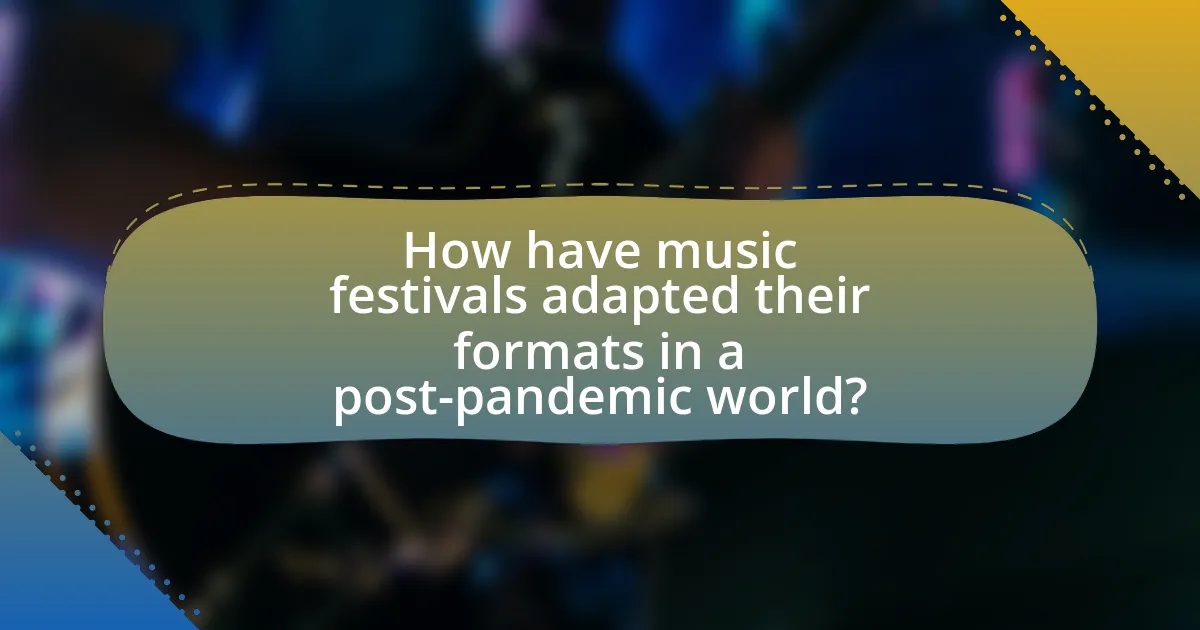
How have music festivals adapted their formats in a post-pandemic world?
Music festivals have adapted their formats in a post-pandemic world by incorporating hybrid models that combine in-person and virtual experiences. This shift allows festivals to reach a broader audience while adhering to health guidelines. For instance, many festivals now offer live-streaming options, enabling remote participation, which was evident in events like Coachella and Lollapalooza, where virtual tickets were sold alongside physical ones. Additionally, festivals have implemented enhanced safety measures, such as contactless entry, social distancing protocols, and reduced capacity to ensure attendee safety. These adaptations reflect a significant evolution in how music festivals operate, prioritizing both accessibility and health.
What new festival formats have gained popularity since the pandemic?
New festival formats that have gained popularity since the pandemic include hybrid festivals, drive-in concerts, and virtual events. Hybrid festivals combine in-person and online experiences, allowing attendees to participate remotely, which became essential during lockdowns. Drive-in concerts, where audiences enjoy performances from their vehicles, emerged as a safe alternative for live music experiences. Virtual events, utilizing streaming platforms, expanded access to global audiences and featured interactive elements, enhancing engagement. These formats reflect the industry’s adaptation to health concerns and changing audience preferences.
How are hybrid festivals combining in-person and virtual experiences?
Hybrid festivals are combining in-person and virtual experiences by utilizing technology to create an inclusive environment for attendees. These festivals often feature live-streamed performances, allowing remote participants to engage in real-time with the event while on-site attendees enjoy the atmosphere and interactions in person. For instance, platforms like YouTube and Twitch have been employed to broadcast performances, enabling a wider audience reach. Additionally, interactive features such as virtual meet-and-greets, chat rooms, and social media integration enhance the experience for both in-person and online attendees, fostering community engagement. This approach has been validated by the success of events like Coachella’s virtual offerings, which attracted millions of viewers globally, demonstrating the effectiveness of hybrid models in expanding audience participation.
What are the benefits of smaller, localized music festivals?
Smaller, localized music festivals offer several benefits, including enhanced community engagement, reduced environmental impact, and increased accessibility for attendees. These festivals foster a sense of belonging and connection among local residents, as they often showcase regional talent and culture, thereby strengthening community ties. Additionally, they typically have a smaller carbon footprint compared to larger festivals, as they require less travel and infrastructure. Accessibility is also improved, as local festivals are more affordable and easier to attend for nearby residents, allowing a broader demographic to participate. According to a study by the National Endowment for the Arts, community-based events like these can significantly boost local economies by attracting visitors and supporting local businesses.
How are festival organizers addressing health concerns?
Festival organizers are addressing health concerns by implementing enhanced safety protocols, including mandatory health screenings, vaccination requirements, and improved sanitation measures. For instance, many festivals now require attendees to show proof of vaccination or a negative COVID-19 test prior to entry, which has been shown to significantly reduce the risk of virus transmission. Additionally, organizers are increasing the availability of hand sanitizing stations and ensuring that high-touch surfaces are regularly disinfected, aligning with public health guidelines to promote a safer environment for attendees.
What protocols are in place to ensure attendee safety?
Protocols in place to ensure attendee safety at music festivals include health screenings, social distancing measures, and enhanced sanitation practices. Health screenings often involve temperature checks and health questionnaires to identify potential COVID-19 symptoms among attendees. Social distancing measures are implemented by limiting crowd sizes and spacing out seating or standing areas to reduce close contact. Enhanced sanitation practices involve frequent cleaning of high-touch surfaces and providing hand sanitizing stations throughout the venue. These protocols have been adopted widely in response to the COVID-19 pandemic to protect public health and ensure a safe environment for festival-goers.
How are vaccination and testing requirements shaping festival attendance?
Vaccination and testing requirements significantly influence festival attendance by creating a safer environment for attendees and encouraging participation among those who are vaccinated or tested negative. Festivals that implement these requirements often see increased ticket sales, as they attract individuals who prioritize safety and are willing to comply with health protocols. For instance, a study by the University of California, Berkeley, found that events with strict health measures reported a 30% higher attendance rate compared to those without such requirements. This trend indicates that clear vaccination and testing policies can enhance public confidence and drive attendance in the evolving landscape of post-pandemic music festivals.
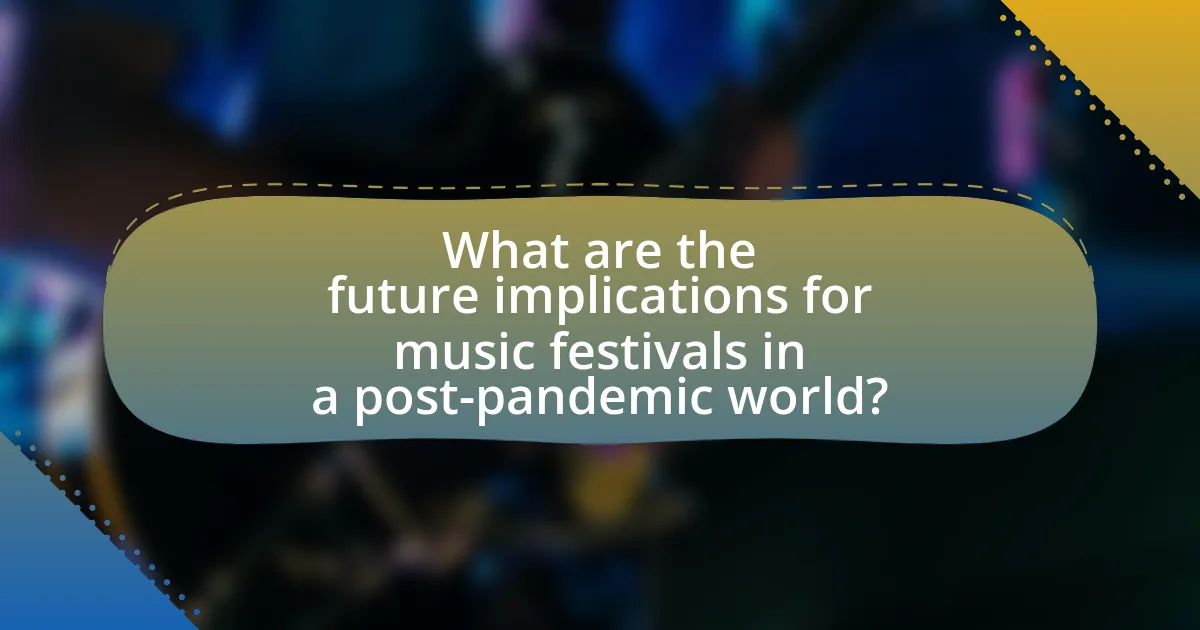
What are the future implications for music festivals in a post-pandemic world?
The future implications for music festivals in a post-pandemic world include increased health and safety measures, a shift towards hybrid models combining in-person and virtual experiences, and a greater emphasis on sustainability. Health protocols, such as contactless entry and enhanced sanitation, are likely to become standard practices to ensure attendee safety. According to a survey by Eventbrite, 70% of festival-goers expressed a preference for events that prioritize health measures. Additionally, the rise of virtual attendance during the pandemic has shown that hybrid models can expand audience reach and engagement, allowing festivals to cater to both local and global audiences. Furthermore, the growing awareness of environmental issues is pushing festivals to adopt sustainable practices, with 60% of festival organizers indicating plans to implement eco-friendly initiatives in the future. These trends indicate a transformative evolution in how music festivals will operate moving forward.
How might the music festival landscape continue to change in the coming years?
The music festival landscape is likely to evolve towards more hybrid models that combine in-person and virtual experiences. This shift is driven by the increased demand for accessibility and the lessons learned during the pandemic, where many festivals adopted online streaming to reach wider audiences. According to a report by Eventbrite, 67% of festival-goers expressed interest in attending virtual events even after in-person gatherings resume, indicating a lasting preference for flexible attendance options. Additionally, sustainability practices are expected to gain prominence, as festivals increasingly focus on reducing their environmental impact, with initiatives like zero-waste policies and carbon offset programs becoming more common.
What innovations are likely to shape the future of music festivals?
Innovations likely to shape the future of music festivals include advanced technology integration, enhanced health and safety measures, and immersive experiences. Advanced technology, such as virtual reality and augmented reality, will allow attendees to engage with performances in new ways, as evidenced by the success of virtual festivals during the pandemic, which attracted millions of viewers globally. Enhanced health and safety measures, including contactless payment systems and improved sanitation protocols, will become standard to ensure attendee safety, reflecting the heightened awareness of public health. Additionally, immersive experiences, such as interactive installations and personalized content through AI, will create unique environments that cater to individual preferences, as seen in recent festivals that have successfully implemented these features to enhance audience engagement.
How can festivals maintain engagement with audiences in a digital age?
Festivals can maintain engagement with audiences in a digital age by leveraging technology to create immersive and interactive experiences. Utilizing live streaming platforms allows festivals to reach a global audience, as evidenced by the success of events like Coachella, which streamed performances to millions online in 2020. Additionally, social media engagement through platforms like Instagram and TikTok fosters community interaction, enabling real-time feedback and participation. Data from Eventbrite indicates that 70% of festival-goers engage with events on social media, highlighting its importance in audience retention. Furthermore, incorporating virtual reality and augmented reality experiences can enhance the festival atmosphere, making it accessible and engaging for those unable to attend in person.
What best practices should festival organizers consider moving forward?
Festival organizers should prioritize health and safety protocols, including enhanced sanitation measures and crowd management strategies. Implementing contactless ticketing and payment systems can reduce physical interactions, while clear communication about health guidelines can build attendee confidence. Data from the 2021 Lollapalooza festival indicated that strict health measures led to a lower infection rate among attendees, demonstrating the effectiveness of these practices. Additionally, incorporating flexible ticket policies can accommodate potential changes in attendance due to health concerns, as seen in various festivals adapting to fluctuating pandemic conditions.
How can organizers effectively balance safety and enjoyment for attendees?
Organizers can effectively balance safety and enjoyment for attendees by implementing comprehensive health protocols while enhancing the overall experience. For instance, they can enforce measures such as contactless ticketing, regular sanitation of facilities, and social distancing guidelines to ensure a safe environment. Simultaneously, they can incorporate engaging activities, diverse lineups, and interactive experiences that cater to attendees’ enjoyment. Research from the International Festivals & Events Association indicates that festivals that prioritize safety measures while maintaining high-quality entertainment see increased attendee satisfaction and retention rates. This dual approach not only fosters a secure atmosphere but also enhances the overall festival experience, demonstrating that safety and enjoyment can coexist effectively.
What strategies can be employed to enhance community involvement in festivals?
To enhance community involvement in festivals, organizers can implement strategies such as inclusive planning, local partnerships, and targeted outreach. Inclusive planning involves engaging community members in the decision-making process, ensuring that diverse voices are heard and represented. Local partnerships with schools, businesses, and community organizations can foster a sense of ownership and investment in the festival, leading to increased participation. Targeted outreach through social media campaigns and community events can raise awareness and encourage attendance, particularly among underrepresented groups. Research indicates that festivals that actively involve the community in their planning and execution see higher attendance and satisfaction rates, as evidenced by a study published in the Journal of Festival Management, which found that community engagement significantly correlates with festival success.

